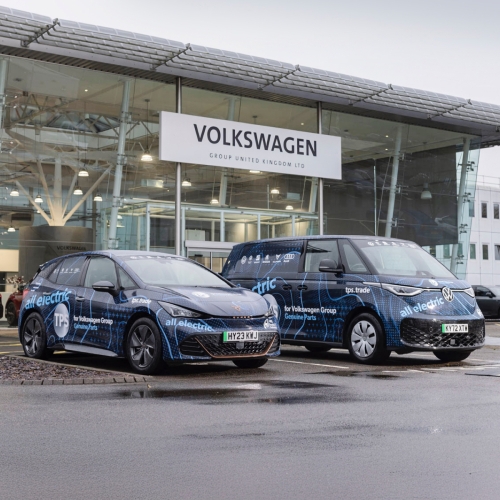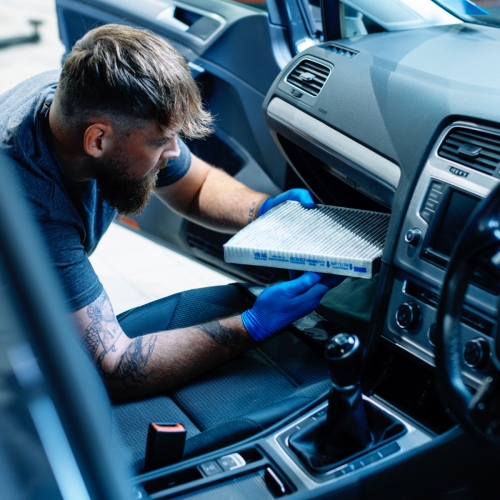
Ben Knight, Technical Support Specialist for Volkswagen Group One Aftersales, returns to Tech Talk to give his thoughts on driver assistance systems. With a focus on the four most common assistance systems, Ben explains the technology behind the driver aids that the modern motorist can’t do without.
Getting into cruise control with driver assistance systems.
Assistance system
Modern vehicles are available with the option of various Advanced Driver Assistance Systems (ADAS). These use hardware and software in conjunction with existing systems such as the steering, brakes and headlights, to make the driving experience safer and more convenient.
What are they?
Four of the most common assistance systems found on Volkswagen Group vehicles are:
- Adaptive Cruise Control (ACC)
- Automatic Emergency Braking (AEB)
- Lane-Keeping Assistant (Lane Assist)
- Dynamic Light Assist
Adaptive Cruise Control (ACC)
ACC uses a radar on the front of the vehicle to measure the distance to the vehicle in front. When the system is activated, the distance between the two vehicles is continually monitored. Signals to the Engine Control Unit (ECU) then adjust the vehicle’s speed to ensure the distance to the vehicle ahead remains constant.
The system has multiple distance presets that can be selected by the driver, all of which are greater than the minimum recommended following distance. If the vehicle in front brakes, the ACC system reacts to slow down the vehicle by sending signals to the ECU to reduce the throttle input, or to the ABS control unit to apply the brakes.
Automatic Emergency Braking (AEB)
The AEB works using the same front-mounted radar as the ACC, by monitoring obstructions ahead of the vehicle. If the vehicle approaches a hazard and the brakes are not applied in time, the system will brake automatically – just hard enough to stop the vehicle before an impact occurs.
ACC & AEB maintenance
There are, as with any assistance system, external factors to the ACC and AEB that may affect its performance. These could include any damage or heavy dirt contamination to the front radar sensor or an electrical or mechanical fault with the braking system, engine or automatic gearbox.
The systems will detect these and warn the driver as well as deactivating the affected system to avoid any incorrect distance calculations or false braking events.
An automatic emergency braking system is now a requirement to obtain a 5-star NCAP safety rating for any vehicle.
Lane-Keeping Assistant (Lane Assist)
Lane Assist uses a camera mounted at the top of the windscreen to detect and monitor the lane markings on the road and keep the vehicle in its lane. If the driver drifts across the lane markings, the system will intervene by sending a signal to the power steering control unit to steer the vehicle back towards the centre of the lane.
A light in the instrument cluster indicates whether road markings have been detected and whether the system is active. Lane assist can be manually deactivated should the driver choose if the indicators are used when changing lane and there is no intervention by the Lane Assist system.
Dynamic Light Assist
Dynamic Light Assist looks at the vehicle’s speed, inclination angle, steering wheel angle and data from the front windscreen mounted camera to assess traffic ahead. When traffic is detected, the windscreen camera sends a signal to the headlight control unit to automatically dip the headlights so as not to dazzle oncoming vehicles. When there are no vehicles ahead, the system automatically activates the full-beam lights.
Dynamic Light Assist also features dynamic cornering lights. Here the data from the steering angle sensor and individual wheel speeds is used to detect when the vehicle is cornering. Small motors in the headlight clusters move the headlight beam left or right, depending on which way the vehicle is cornering, to illuminate more of the road ahead.
LED matrix headlights are also available on some of the latest Volkswagen Group vehicles. They use up to 75 individual LEDs in each headlight cluster to control the dipped and main beam light functions.
Calibration
Calibration of the ADAS system is required if any of the sensors, camera or control units have been replaced, have moved (for example a front bumper repair or a windscreen replacement), or if the wheel alignment or vehicle’s ride height has been changed.
Without the correct calibration of the front radar, the front camera or dynamic headlights, the functions of the system will be impaired. If any of the ADAS control units detect a fault, the system will be deactivated and the driver will need to visit an approved repairer to recalibrate the system.
For Volkswagen Group vehicles, there are either static calibration or dynamic calibration.
Static calibration
Static calibration is performed in the workshop. The vehicle is driven into a dedicated area or onto a four-wheel alignment ramp. The area will have been pre-calibrated when installed to ensure it is flat and level.
The vehicle’s ride height is checked, as well as the wheel alignment. For the adjustment of the ACC radar, a radar reflection board is placed an exact distance and height in front of the vehicle. For the front camera, the same is done with a target board printed with a unique pattern.
Communication with the car via a Volkswagen diagnostic computer is established and a calibration test is carried out. The control unit stores the measurements and the process is complete.
Dynamic calibration
Dynamic calibration is carried out on the road. A programme will be started via the Volkswagen diagnostic computer and the vehicle is driven in calibration mode until the programme indicates a successful outcome has been achieved. Dynamic calibration is the preferred method, however in some cases a static, or a combination of both methods, will be required to successfully complete the process.
ADAS systems make driving safer, easier and more enjoyable. The use of these systems reduces accidents and enhances driving situations such as nighttime or motorway driving.
The safety and convenience provided by ADAS systems will eventually be commonplace on all vehicles, with the scope to evolve further to provide even greater functionality in the future.



